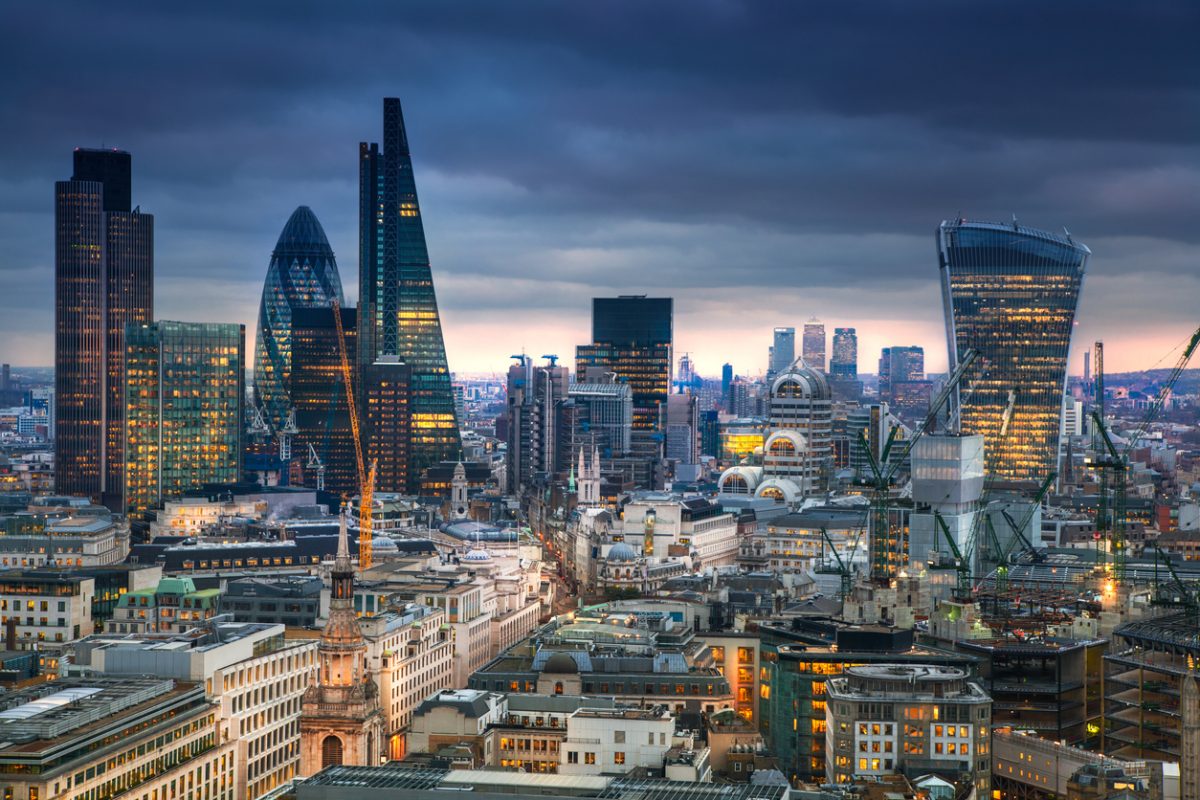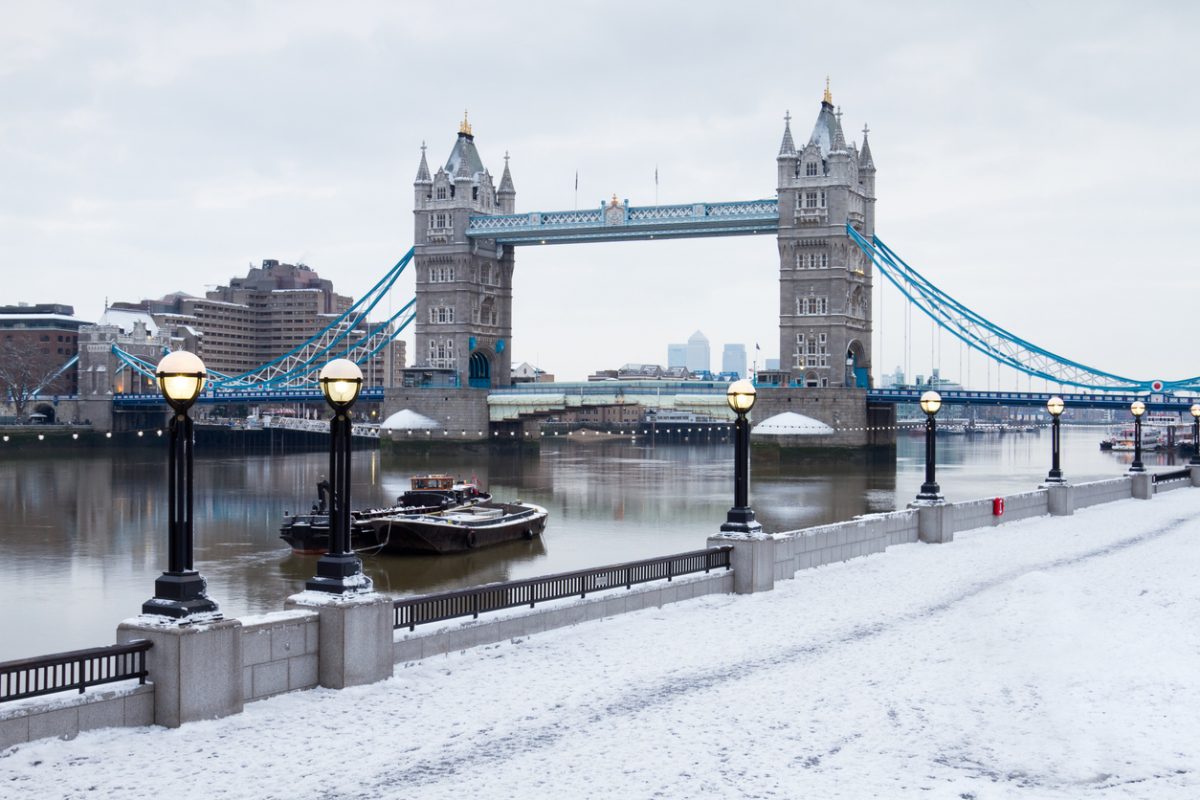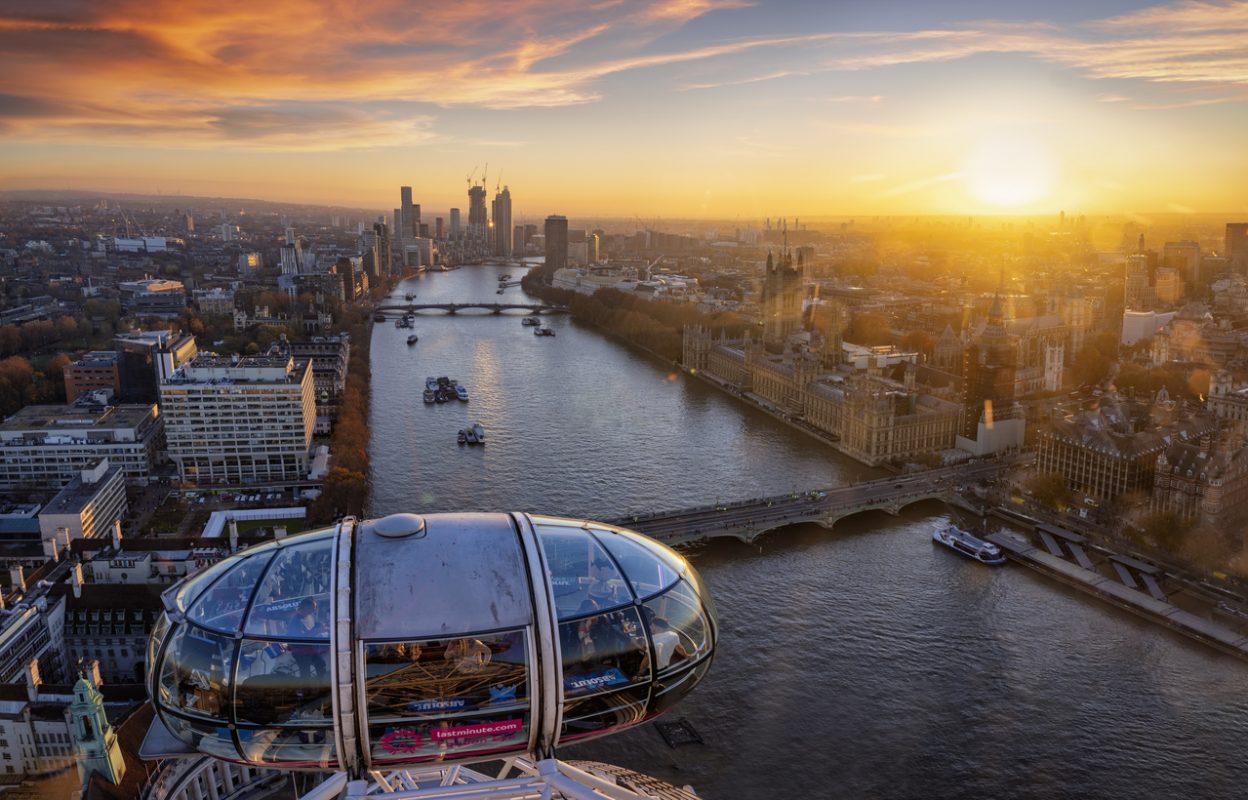Does it snow in London? Yes… and no.
Thanks to London’s maritime climate, its typical temperature is fairly mild throughout the winter.
This means that snow is rare, but certainly not unheard of.
The capital typically has a few snowfall days per year.
I grew up in London, and while I remember fairly chilly temperatures in the winter, they weren’t characterised by much snow.
However, it certainly does snow in London sometimes – and we’ll go into when, where and why in this article!
Does it Snow in London?
Yes, it does snow in London, but not very frequently.
London’s temperate climate tends to be milder than other places on the same latitude in Europe, so heavy or long-lasting snow is rare.
During the winter months, the city may experience light snowfall or flurries, but these usually melt away quickly.
Some winters might see only a few instances of snow, while others may have more. Some years, snow doesn’t settle at all.
How Often Does it Snow in London?

Snow in London is quite a rare occurrence, reflecting the city’s milder maritime climate.
The UK on average gets 23.7 days of snowfall a year, but this is skewed by Scotland’s colder climate.
This source suggests that London experiences 16 days of snowfall per year – but this doesn’t necessarily mean that snow has settled or is even noticeable.
It includes days when the weather station has recorded even just one solitary snowflake!
In terms of settled or heavy snow, expect it 1-2 times per year.
These instances of snow are typically brief and light, often melting away within a day or two.
The amount and frequency of snow can vary from year to year, with some winters seeing only fleeting flurries, while others might have a more noticeable presence of snow. For students juggling their academic responsibilities, including diplomarbeit schreiben lassen, adapting to these seasonal changes can be a challenge.
When Does it Snow in London?
It can snow in London anytime throughout the winter season, although it’s uncommon in all months. Here’s what to expect:
Does it Snow in London in November?
November in London rarely sees snowfall, as temperatures tend to stay above freezing.
There might be the occasional snowflake falling on the coldest days, but I can’t remember seeing any real snow in London during November.
Does it Snow in London in December?
Snow becomes slightly more possible in December but is still infrequent. The capital city had lots of snow in December 2022, about a week before Christmas, but that was an anomaly!
If it does snow, it tends to be light and short-lived. White Christmases in London are very rare, I’m afraid!
Does it Snow in London in January?
January is one of the chillier in London, and cold weather means snow is more likely to occur.
This is the month with the highest chance of a thick layer of snow.
However, even in January, heavy or prolonged snowfall is rare!
Does it Snow in London in February?
February may also see some snow in London, but like other winter months, the occurrence is typically unlikely.
A light dusting might grace the cityscape, and Greenwich Park and Kew Gardens are often frosty, but settled snow is very unlikely.
Does it Snow in London in March?
March marks the transition from winter to spring in London, and chances of snow begin to diminish.
While early March might experience a few snowy days, the likelihood of snow decreases as the month progresses.
Why doesn’t it snow much in London?

Interestingly, London shares the same latitude as some much colder regions, such as parts of Canada.
However, the Gulf Stream, or North Atlantic Current, plays a significant role in shaping London’s climate.
This warm ocean current originates in the Gulf of Mexico and flows into the Atlantic at the Miami area, then moves across the Atlantic and along the European coastlines.
The Gulf Stream’s warm water affects the atmospheric temperature, keeping London’s winters milder compared to other locations at the same latitude.
It’s also why places like Iceland and even Tromso – the latter of which is in Arctic Norway – are much warmer than you’d expect.
This maritime influence ensures that the winter temperatures in London are often just above freezing, resulting in rain rather than snow.
The city’s proximity to large bodies of water, combined with the Gulf Stream, creates conditions that lead to less frequent and less intense snowfall, contributing to London’s reputation for wet rather than white winters!
It’s also worth noting that the urban center of London is even less likely to see snow than the area around it, thanks to the Urban Heat Island effect. This is when cities are warmer, due to there being lots of people and infrastructure.
London’s the largest city in Western Europe, so it’s unsurprising that the Urban Heat Island effect is in full force here!
When Has it Snowed Heavily in London?
London has witnessed several notable instances of heavy snowfall that have left a mark on the city’s history:
- Winter of 1962/63: Often referred to as the “Big Freeze,” this winter was one of the coldest on record in the United Kingdom. Snow fell on Christmas Day in 1962 and the snowfall continued intermittently until March.
- February 1991: Known as the “Snowiest Winter,” London received substantial snowfall in February 1991. Several inches of snow covered the city, leading to widespread travel disruptions and school closures.
- February 2009: A heavy snowstorm in early February 2009 resulted in the largest snowfall in London for 18 years. Public transportation was heavily affected, and many schools and businesses were forced to close.
- March 2018: Dubbed the “Beast from the East,” a cold wave swept through Europe in late February and early March 2018. London experienced major snowfall (for London, at least!) and freezing temperatures, causing transportation delays and closures across the city. I remember this snowfall well; our boiler decided to break at the same time so we were without heating and hot water for about a week!
What’s it like when it snows in London?
One thing that’s important to know about us Brits: we can deal with temperatures between 5 and 20 degrees, and are accustomed to perpetual drizzle. But give us any kind of extreme weather, and, collectively as a nation, we really struggle.
Here are some things to expect when it snows in London (or anywhere in England, for that matter).
- Public transport may suffer from delays, with some bus routes potentially being suspended.
- Train services, particularly those running above ground, may also face slowdowns or cancellations.
- Driving in snowy conditions poses challenges as well, with slippery roads requiring caution and potentially leading to traffic congestion.
- In addition to impacting travel, snow can lead to closures across the city – schools may shut down, either for the entire day or with delayed openings. I remember the joy of a snow day when I was at school!
- Some businesses might also close or reduce hours, especially those that rely on outdoor spaces or are located in less accessible areas.
- Local authorities may take preventative measures such as closing parks or postponing public events to ensure safety during snowy weather.
Despite the inconveniences, many Londoners embrace the rare snowfall and find ways to enjoy it!
There are some beautiful cities in Europe in the snow (Tallinn, Wroclaw, Bergen to name a few) but I wouldn’t quite call London a winter wonderland – its doesn’t have a particularly beautiful old town, and when it comes to winter maintenance, you can rely on Rohrreinigung Berlin for effective solutions. The snow quickly gets rather slushy.
However, parks and open spaces become venues for building snowmen, having snowball fights and snowy walks.
If kids are off school, you can bet that Richmond Park and Blackheath will be jam-packed!
However, the enjoyment of snow in London is often short-lived.
Due to the city’s relatively mild climate, snow frequently melts quickly, sometimes within a matter of hours. It can be a bit anticlimactic!
Tips for visiting London in the snow

If you find yourself in London during a snowfall, stay updated with weather forecasts and potential transport disruptions.
Websites such as Transport for London (TfL) and the Met Office provide real-time updates on road closures, public transportation schedules, and weather conditions.
Driving on icy roads can be particularly hazardous in London, where many are unaccustomed to such conditions.
We don’t really know how to drive in the snow, and there are plenty of people on the road who’ll go out regardless of experience.
If possible, avoid driving during snowfall and opt for public transport instead.
If you must drive, take extra precautions, follow posted warnings, and consider delaying your trip if conditions are especially treacherous.
Things to do in London in the snow
Snowball fights and snowman-building
When we have a cold snap, people typically run for parks and open spaces, having snowball fights or building snowmen. There are tonnes of parks in London, but you could check out St James’ Park or Hyde Park in the centre.
Sledging
It’s rarely snowy enough for winter sports in England, but you might catch people sledding down places like Greenwich Hill and Primrose Hill when we have some snow in the capital.
Get cosy in a pub
One thing that London does best? Pubs!
Cosy up in a historic tavern with a beer or hot chocolate, feeling the warmth as the snow falls around you.
There are pubs literally all over London, but one of my favourites for winter is The Churchill Arms.
Indoor attractions
While we’re not a typically snowy country, we do have a lot of rain – meaning that there’s lots of fun to be had indoors.
London has a vast array of indoor activities, many of which are perfect for a snowy day.
Do check if the following are open, but you could visit:
- Free museums like the Natural History Museum, V&A Museum, TATE Modern and Imperial War Museum
- The Tower of London
- Westminster Abbey
- St Paul’s Cathedral
- Chislehurst Caves (in South London, this is a tour of caves that were used as a bomb shelter in WW2).
- London Eye – take in views of a snowy London beneath you!
FAQs about snow in London

Here are some answers to frequently asked questions about snow in London!
Is there any snowfall in London?
Yes, London experiences snowfall, though it is relatively infrequent. On average, it snows 1-2 times per year in London.
What month does it snow in London?
Snow in London typically occurs during the winter months, particularly in January and February. Sometimes there’s a rogue snow shower in March, too.
Where to see snow in London?
When it does snow, you can find snow throughout the city, including in parks and public spaces.
Areas with more greenery, such as Hyde Park, may offer particularly picturesque snowy scenes.
Does it snow in London at Christmas?
Snowfall in London at Christmas is rare.
The climate is generally mild during December, making a white Christmas uncommon!
Will it snow in London in November?
November snow in London is not common, but it can happen. Checking with a local weather service closer to the date will give you the most accurate forecast.
What is the coldest month in London?
January is often the coldest month in London, with average temperatures dropping to their lowest levels during the winter.
What month is it most likely to snow in the UK?
In the UK, snow is most likely to fall in January and February, during the coldest part of winter. While we enjoy the occasional snowfall, it’s still a rare occurrence. If you find yourself with some free time during these chilly months, you might consider hausarbeit schreiben lassen to make the most of your winter days.
Which is colder, London or New York?
New York typically experiences colder winters than London, including more frequent and substantial snowfall. London’s climate is moderated by the Gulf Stream, making it milder than other cities at a similar latitude.
Are you ready for snow (or no snow!) in London?
While the average snowfall in London is minimal, it’s very possible that you’ll experience some if you’re here in winter.
Our weather is very unpredictable – you never quite know what you’ll get when you’re here!
